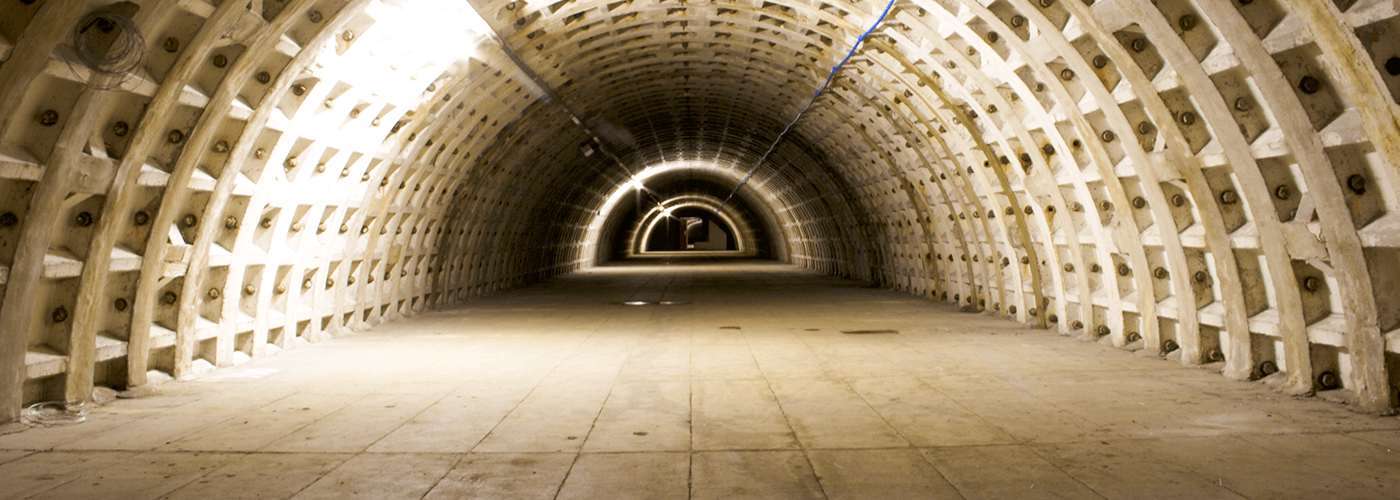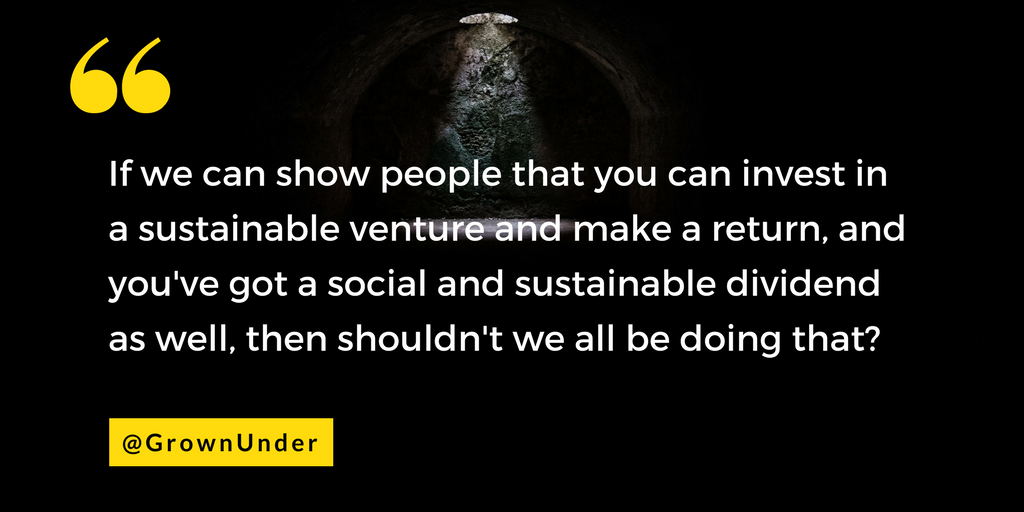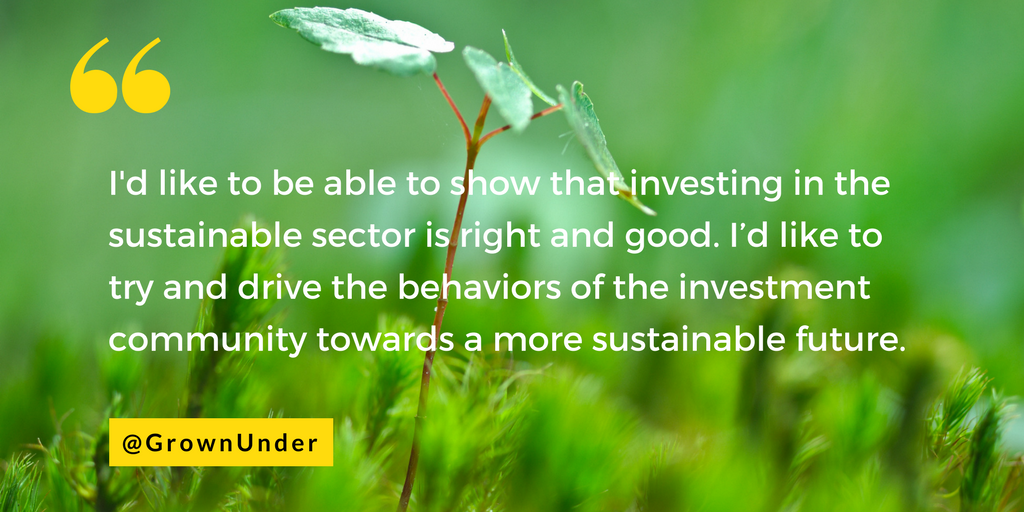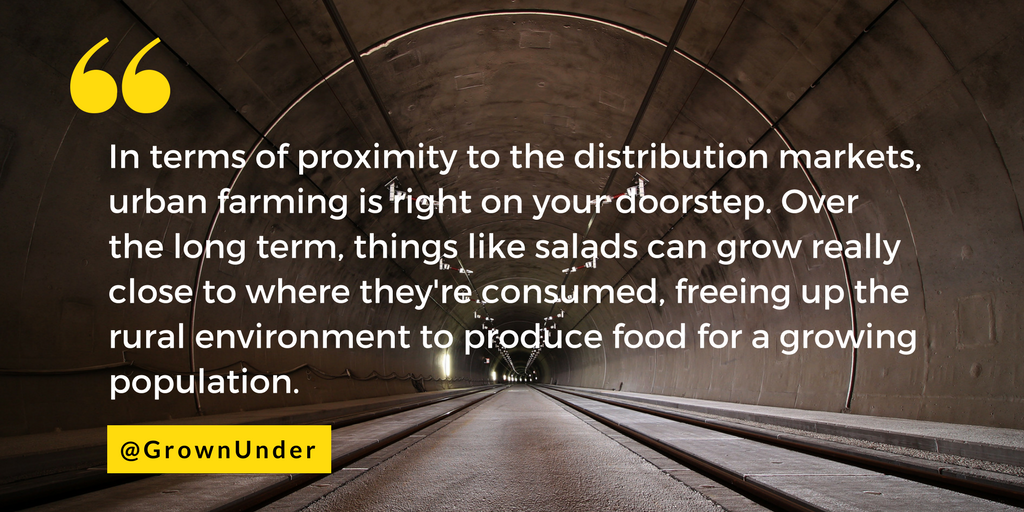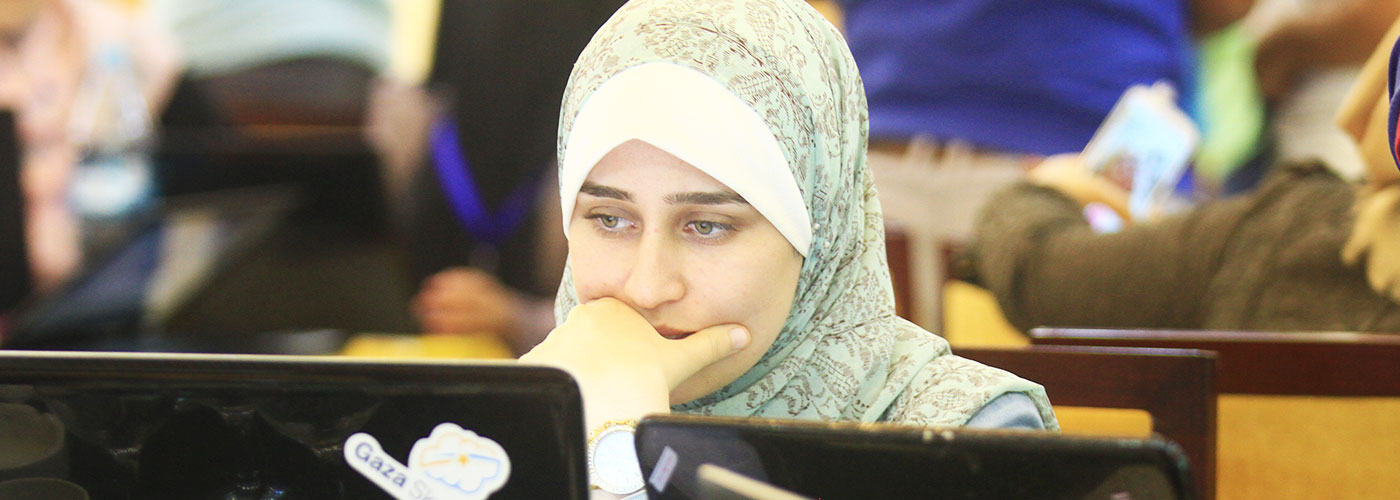Today, miles of empty tunnels run beneath the streets of London. The government constructed them over one hundred feet beneath the surface to serve as shelter during the air raids of WWII. However, after the war, many of these tunnels were left abandoned. Funding to convert them into tube lines ran dry.
Over time, the spaces took on various identities – from the storage of government documents to temporary accommodations for Caribbean immigrants. One of the more recent applications, though, is breathing new life into a space once associated with a dark history.
Growing Underground grows fresh micro greens and salad leaves in one of these quiet tunnels beneath the bustling streets of Clapham, South London. A combination of hydroponics and LED technology, the closed-loop farm grows crops year-round in a controlled environment with no pesticides. Due to hyper-local production, the team boasts that the produce can be in your kitchen within four hours of being picked and packed.
Unreasonable visited the underground farm and spoke with Steven Dring, co-founder of Growing Underground, about discovering the potential of urban farming and unleashing a degree of belligerence to make it succeed.
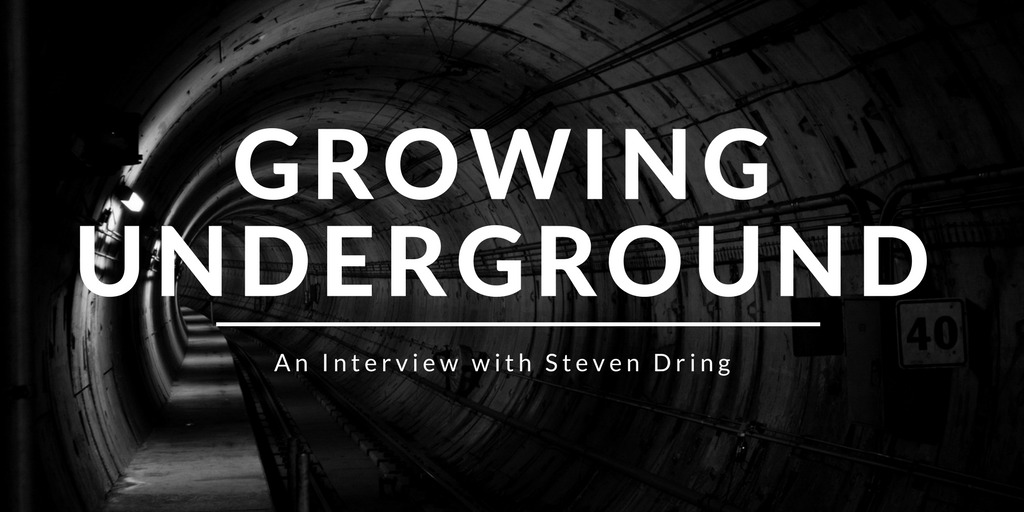
So, take me back to your corporate life. I want to hear a little bit about your journey and various work experiences along the way.
S: I worked for a PLC for 17 years, joining as a 20 year old. Literally, I was being promoted year after year. They then paid for my education as well, so there was all this buy-in and gratitude. They were a great employer in that sense. It was just the fact that I changed in terms of my views on sustainability and my views on where we were going as a planet. So as I was changing, the bits within the business that really didn’t sit with me just became more pronounced.
I can remember the moment when I sat in my office and I received a letter that said, “Your pension matures in 2039,” and I thought, no it doesn’t! That was a catalyst. So yeah, I quit.
I heard something about a suit-burning party…what was that all about?
S: That entailed me bundling all my suits together – leaving only a brown one for summer, a dress one for black tie, and a blue one for the city. Everything else got carried to a big oil drum that was in our garden, where we burned leaves and things like that. I may have had an alcoholic drink in my hand and, yeah…I put on an accelerant and enjoyed the flame.
Tell me about how Growing Underground got started.
S: Richard, my business partner, and I literally grew up in villages next to each other, right in amongst agriculture on the edge of the city where the countryside starts. So we knew about farming and agriculture and the pressures of that.
Did you know anything about this type of growing or farming?
S: Not at all. Years later, when Richard moved to London, this idea evolved. Usually on Friday nights, Rich would come down near where I lived and we’d go to a local pub and end up arguing for hours. We had many conversations about the democratization of energy and water scarcity and growing populations – we were that boring in the pub.
We are taking a space that really had a lot of negative connotations and turning it into something much more powerful. Tweet This Quote
But when Richard said there’s this thing called vertical farming, we looked into the academia behind it, and it stacked up. This was opening my eyes at a time when I was thinking I needed to do something different. One night in the pub it was, OK, let’s stop talking about it, and let’s do something about it. And Richard said, well can you actually try and throw that into a business case?
But what became apparent at that point was that we knew sod all about growing. We needed to get somebody around us. We found an LED supplier in Finland just from Google research, and next thing you know, a guy named Chris came through. He went back to his wife in Yorkshire and said, these guys are trying to build a farm underground. And she just thought it was a massive wind-up. But, we brought Chris in as a founder of the business within two weeks of taking the whole thing seriously.
So what gave you the courage and passion to just go after this?
S: I think the reason to go at it was the business case. We did two years of planning and research to understand the market and spent sleepless nights going to talk with the traders down at the food market. We sat in the British Library reading reports to understand fresh produce. It was a case of right, if we’re going to ask people for a million pounds for an idea, then we kind of need a fairly robust business plan. So, that’s what we did – two years of business planning.
I’d always made profit for people all my life. I thought we could affect the most change by showing everybody the financial dividend and a reason to invest in this market, as well as all of our sustainable and social goals we wanted to achieve. I thought we could do both and do things quicker if we weren’t a not-for-profit. Richard and I argued about it, and we struggled with all of that to start, but then I won the argument.
If we can show people that you can invest in a sustainable venture and make a return, and you’ve got a social and sustainable dividend as well, then shouldn’t we all be doing that?
Tell me a brief history about these tunnels. They have clearly undergone a massive transformation from a previous time in human history.
S: It was built as a WWII air raid shelter. I think the plans were drawn up in 1939, and they were finished building in 1941. You look at the engineering that’s gone on down here – the blood, sweat and tears it would have taken to build this space, and then the fact that it housed people whilst London was being bombed – it’s kind of mind-blowing what took place.
We need to show the investment community that sustainable businesses are the future. Tweet This Quote
I struggle to get my head around the concept of being housed down here with 8,000 other souls. It’s gone through a strange life, this building. Then, it sat here empty. We are taking a space that had a lot of negative connotations and turning it into something much more powerful.
When you discovered the tunnels, do you remember realizing the potential opportunity here? What did that feel like?
S: I remember the phone call to the guy at Transport for London when I said we want to meet and rent your tunnels. He was like, “You can’t do a nightclub.” We said we don’t want to; we want to build a farm. And I think at that point he was like, what? He literally came out a couple of days later and met us. They were really forward thinking and supportive.
Tell me more about the space you’re using for farming down here.
S: So we’ve got a huge space, at least 70,000 square feet, and we’re using a tiny portion of that so far. The good thing for us is expansion is just building another section of farm. I don’t need a new building. This came from Chris and other advisors around us saying, if you are going to do this, you need to do it on a commercial scale. Otherwise, you’re just going to be a market garden. Like, you really need to be able to get your economics right. So that was the reason for going somewhere big like this.
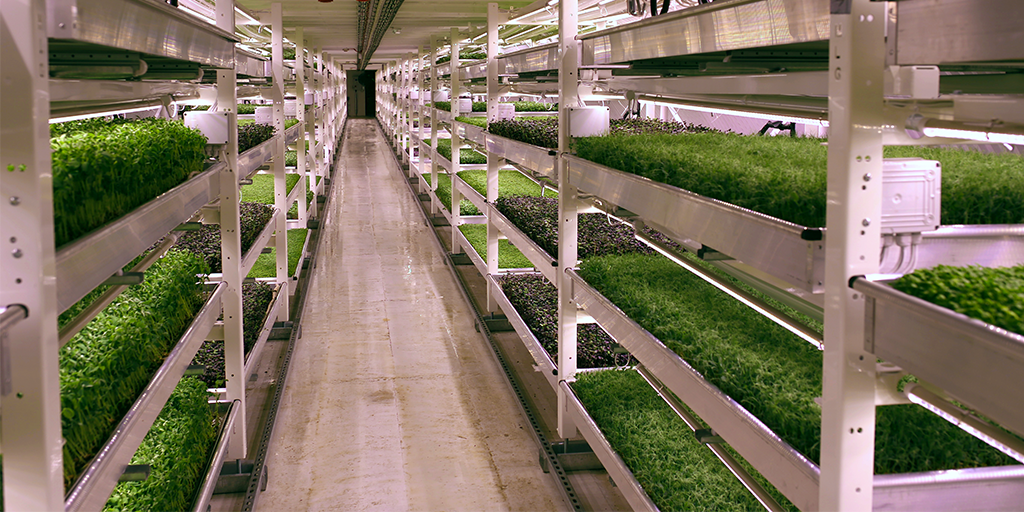
The four levels of the underground farm. Photo from Growing Underground.
Right now, we grow on four layers. When we’re maxed out, it’s going to be a couple of hectares of growing space down here. And then it’s two linear tunnels: one would have been the northbound tunnel and the other the southbound tunnel (each a half kilometer long) if they ever turned it into the tube. That’s what’s was genius about the build, actually, the fact that they realized the war was going to be over one day, and they would turn it into a tube line. They never did because they never found the money, so we turned it into a farm.
Can you give me a brief overview of how this whole process works?
S: It’s really easy. You throw around some seeds, stuff grows, and we sell it. It’s just very straightforward. A substrate, which is a recycled carpet, acts as our soil. The guys scatter the seeds on there in a uniform way. Then, we take that product and put it into propagation, which is basically just high humidity in the dark. That acts like the product is underneath the soil, so we just recreate that environment, keeping it a constant 25-30 degrees Celsius.
From there, the roots start to take hold in the substrate. At that point, we move them underneath the lights, and they stay under the lights from 6-20 days, depending on what you’re growing. Then, it comes out for cutting. We pack it, put it in the fridge, and it goes out 4-12 hours later.
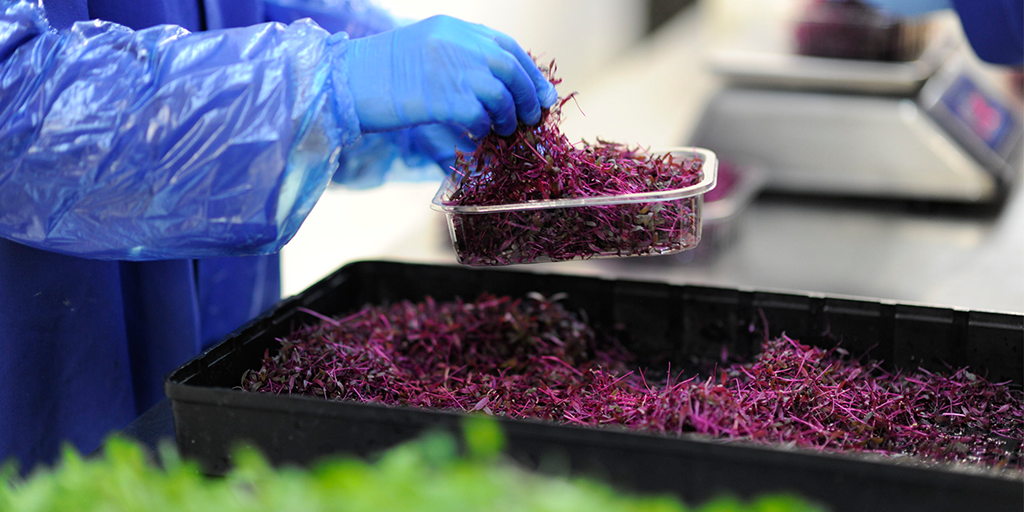
Packing micro greens and getting them ready to distribute. Photo from Growing Underground.
So that’s the process. We take LED lighting and hydroponics, put them together, and use them to grow fresh produce. Hydroponics has been around since the Roman times if not before. In the 70s in this country, it was perfected as a commercial and efficient way of growing crops. And so we’ve not really done anything revolutionary apart from all that’s evolved in LED lighting.
Where does the produce go when it’s packed and ready?
S: At the moment, it goes into the wholesale markets, and that goes out to thousands of restaurants across London. We currently have an online offer as well and one at a farmer’s market. In the future, there will be retail offers, which is the large mover of produce.
And what types of micro greens do you grow?
S: We actually grow a mix of micro greens and baby leafs. So baby leafs are like mizuna, pea shoots, and red oak lettuce – all leafs that you find in a standard pack of salad. Then, for the micro herbs, we grow fennel, green and red basil, coriander, celery, and parsley. Chefs like them because you’ve got real intense flavors, but they don’t dominate the plate.
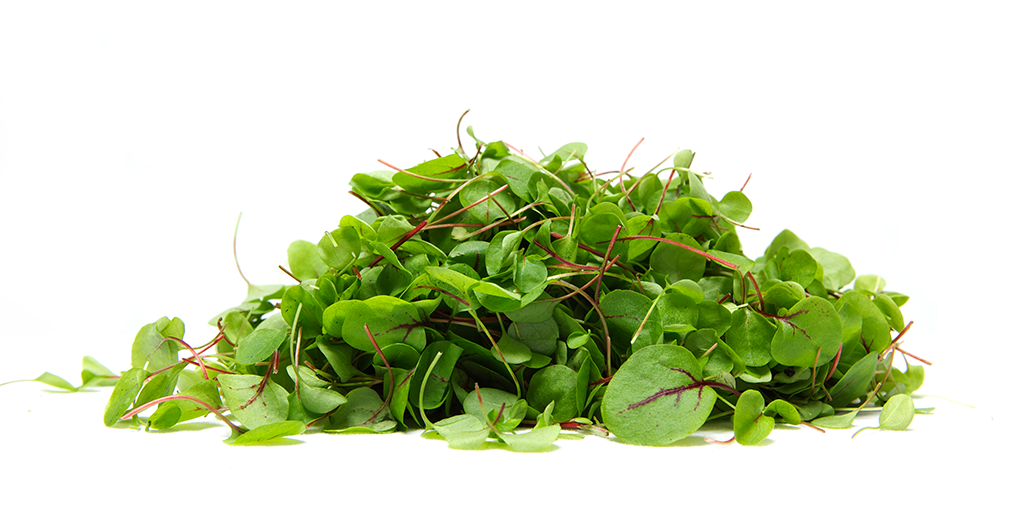
Micro greens up close. Photo from Growing Underground.
How does it compare to other produce? What makes it stand out from anything these chefs have used before, for example?
S: What makes us stand apart from our competitors is the speed of transit to get produce to the market. By the time it gets to the customer, it still has its intense flavor, and the shelf life is longer. The chefs like the security of the supply chain. It’s secure because of where we grow it, but it’s also the consistency. Because of this environment, there aren’t variations in quality.
The game changer for us will be when we start to put a product through retail and hit volume. That’s when we start to get to more ubiquitous and affordable products, which is what you want to be able to do in terms of feeding more people. Not everybody eats micro herbs. I don’t take a pack of 30 g of coriander home on an evening and use them, you know – that’s a lot of coriander.
London’s going to have another 2 million people by 2025 alone. We have to feed them. Tweet This Quote
But when you start putting that into retail and supplying to the masses, then you can affect more change. Then, we start taking food production from the rural into the urban environment. But we’re never going to do that with just micros. We’re trying to do something quite noble in terms of food production, but the product we grow at the moment goes to high-end chefs and catering. Inevitably, there’s a massive dichotomy between the two, so we have to be honest about the fact of where that product is going now.
Why have urban farms? Why is it so important to have farms underneath London?
S: So there are loads of reasons for urban farms. The first one, the argument that Richard and I started with, is the growing population. The UN says there’s going to be billions of people by 2050, and London’s going to have another 2 million people by 2025 alone. We have to feed them. Where is the energy going to come from? Where is the water going to come from?
Then, you look at agriculture. Actually, we can get yields up and do it sustainably. It’s just a case of taking all the best practices from agriculture and saying, well we don’t want agricultural runoff, and hydroponics uses 70 percent less water. So that was the case for urban farms.
But then, you get the locality of it. In terms of proximity to the distribution markets, it’s right on your doorstep. You not only have the connection with the local community and the creation of jobs, but you also have a connection between grower and consumer. Over the long term, things like salads can grow really close to where they’re consumed, freeing up the rural environment to produce food for a growing population.
Tell me about the struggles.
S: Many times a day, I think that I don’t know how to do this. There are many different struggles you go through. I think elements of the bureaucracy are always a challenge, and attracting investors to an emerging sector is always a challenge, and they cause you frustration. But you have to have a certain amount of belligerence to say, “We’re going to build a farm in a tunnel, and that’s it.” Rich and I sat on many occasions and just said, yeah, just be belligerent about it.
What do you hope your business will do for future generations?
S: I’d like to see us expand our operations into many different areas in the UK and other geographies. I’d like to see us have an impact in terms of job creation, and I’d also then like to show that investing in the sustainable sector is right and good. We need to show the investment community that sustainable projects and businesses are the future. I think once they get on board with that, then change will happen a lot quicker.
We’re using food as something to break down barriers and engage in your local community. Tweet This Quote
We are pushing back against something that’s really significant in terms of global climate change, sustainability, and just socially how we treat each other. We’re using food as something to break down barriers and engage in your local community, rather than just being a producer in the middle of nowhere, and your produce ends up on a shelf in front of me in a supermarket. We’re trying to change all elements of that.
So entrepreneurship is hard. The food industry is also hard to break into. How do you wake up every day inspired to keep going for it?
S: At the start, what got me out of bed every day was how terrible the food system was. Now, it’s possibly a belligerence to make it a success – whether it’s about job creation, the social end of the business, or the financial dividend. I think it’s something about wanting to make sure you affect the change you want.
You have to have a certain amount of belligerence to say, we’re going to build a farm in a tunnel. Tweet This Quote
We don’t take no for an answer, and we are stubborn. But a thing someone said to me ages ago was that obviously you’re going to have competitors. Just make sure they know you’re having way more fun than they are. And I was like, yeah, that’s the attitude to embrace. You have a choice of an attitude in the morning when you wake up. You can go at it being a miserable sod, or you can go at it saying, “Well, OK, let’s do it!”
So, yeah there’s belligerence, but there’s also a great group of people to pick you up when you’re having a bad day, who you can have a laugh with, and who are trying to do something different in the right direction.
This company participated in Unreasonable Impact created with Barclays, the world’s first multi-year partnership focused on scaling up entrepreneurial solutions that will help employ thousands while solving some of our most pressing societal challenges.


